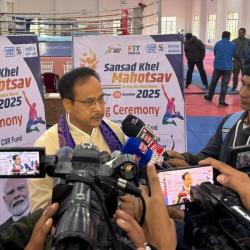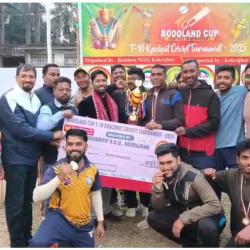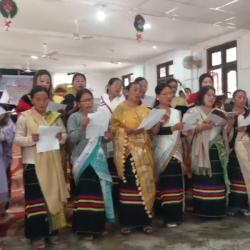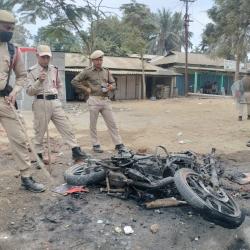As soon as we landed at the Suvarnabhumi (pronounced ‘su-wan-na-poom’) Airport in Bangkok, the guide lead us to a tourist bus. In the bus, the tom-boyish jovial lady says to us, “Welcome to Thailand, the land of gold, the land of white elephant,.... .” Lets see for ourselves if these sobriquets are relevant. She went on, “In Thailand, 95% people are Buddhists. We eat meat.” The Buddhism in Thailand didn’t spread directly from India. The import was via Sri Lanka in 3rd century B.C. There more than 35,000 Wats (Buddhist monasteries or temples) in Thailand, a country of 513,115 sq. km. Whether these have been able to shape the life of the people in the country is a different thing.
Suvarnabhumi Airport, also known as New Bangkok International airport (NBIA), confirms to international standards and is no less to airports which can be called ‘international’. This is very essential for a country which has to make a first impression on tourists pouring in from different countries, especially from U.S., Europe and Australia. The highways are well-maintained and the sideways are well-kept. There is no settlement right on the roadside. The vegetation and climate is similar to our home state Assam.

The journey was now headed for a 147 km ride south-east of the country to Pattaya, a city which thrived on beach resorts. It was in the intiniery of our tour. We hear about some infamous aspects of the place, but I underestimated the magnanimity. It was only after a visit to the place which made us realize that the place is not really healthy for a trip with your family. The hotel we put up was a nice place to be. Later in the evening we left for the Alcazar show, akin to a cabaret show which was very colourful which bright costumes and a great stage set-up. After the show several people pose with the stage artists. Men especially are more enthusiastic in striking a pose with the gorgeous ladies. Like anything Thailand, this exercise doesn’t come for free. People literally live on tips and you have to shell out some money for this. In the bus, our guide let us know that all the artists dressed as ladies were actually boys or young men. They have undergone sex change as it helps in many ways in the atmosphere of aggressive beach tourism one would find in Thailand. Transvestite cabaret shows are popular. I was amused for the man whom posing with his head placed on the cleavage of one of those ‘ladyboys’ (kathoeys). If he doesn’t know the reality, he will be very disappointed.
Most of us who who plan a trip to different destinations pick up tourism booklets, pamphlets or guide books. Since these are written by a tourism department of the respective place, we find the reality is different from the ideal projection. I remember reading about the pristine beaches and tropical seas of Pattaya and a demure Thai lady placed with a folded hand over the little booklet. But a visit changes your perception. Most of the visitors to Pattaya no longer come to the ‘international’ beach resort for pristine beaches and tropical seas. The sands are white, the sea is blue. But no longer pristine. Tremedous commercialization of tourism and its huge growth as an industry has robbed Pattaya of its original natural attractions. That has been lost to uncontrolled tourist flow and ‘development’. A speedboat took us to a place in a nearby island where one can supposedly gaze at vivid tropical fish and coral. We boarded on a glass-bottomed boat in the hope but the undersea environment is as depleted as the oversea.
Provisions for adventure sports are aplenty. Parasailing, sailing, water-skiing, snorkeling, swimming and different activities in the seas can be availed. Apart from the beach of Pattaya city, there are beaches across nearby. We were taken to one such. If you have been to Goa, its not very different but for the colour of the sands. Here the sand is white unlike Goa where it is ochre and brown. There are rows and rows of arm chairs. Many ladies and men come around offering tattoos and foot massage to the tourists. There are others who bring around shells, net hangings, hand fans etc for sale. There are rows of shops selling momentos, hats, bags, swim-wear, junk jewellery etc. There are rows and rows of eateries offering food and drinks. Smoked sea food, especially prawns are found in many eateries. They place the well-smoked ones at the edges of the grilled net over the charcoal chamber and keep an eye on the newly placed ones, lest they don’t catch ash. In the afternoon, we head to the hotel for lunch and have an entire evening for ourselves. After lunch and a short nap, we venture out on the streets of Pattaya. It was early evening. We had a some noodles for evening snack. Thai noodles. Flat and not very long. The small eatery had idol of Buddha, and photos of the present king and the present queen of Thailand. The people seem have surrendered to unquestionable resolute monarchy. The picture of the Prime Minister was not seen. Ministers come and go. King stays till he dies. The idea of Constitutional Monarchy was brought about by king Vajiravudh (1910-1925), who was educated in Cambridge. He called himself Rama VI.
It is a common sight to see Thai ladies move around with a Western male tourist. They hire for their period of stay. Many are fat old men. Thai women prefer White males. It means they are from the U.S. or Europe and will carry Dollars, Pound Sterlings and currencies of the developed world with higher value. Pattaya is a place where more Thai women than men. This is because women and transvestites flock into the place to cash on the prevailing scenario. In Thailand, prostitution is illegal. But things seems to exist only in paper in this country.
The streets are lined with massage parlours which offer Thai massage and foot massage. The density of massage parlours is amazingly high in this city (which looked more of a town with multi-storeyed hotels). Girls and women await for customers. Some look deceptively innocent. Many massage ‘shops’ offer Thai massage with and lotion massage. One can try in these. But for authentic Thai massage, one should head for the massage centre called ‘Pavilion’. Here the masseurs are trained and know what a Thai massage is all about. It is a form of dry massage, which doesn’t involve a drop of water or any liquid. Both the person who is undertakes the massage and the masseur is fully clothed. It is unique. The origin is traced back to 2500 years, and is said to be practiced by the monks. My experience of the Thai massage felt like the masseur lady made me do yoga forcefully. The hope of falling asleep blissfully for an hour was shattered.
Late in the evening and as night creeps on, the street life and beach life offer different sights. As we moved to the hotel in the bus after dinner, the street-side restaurants, go-go bars thrive with activities best pleased to males. Creepy females clung onto hefty clients. Since hair and breasts have become highly manipulative, I tried to guess the gender by the calves of the legs (though this is likely to betray too). Rounded calves, means the lady in action is a female. Not well-rounded calves; might be male or ‘she-male’. (If the heads of an average Thai man and woman is tonsured, it would be a bit confusing to identify their gender looking at their faces). Many women and ladyboys move about on the beach road and walking street, awaiting prospective clients. (One should be careful as Pattaya is prone to crime). In the road-side open bars, the poles near the drinks were agog with girls and women (some may be the ‘ladyboys’), twisting and turning round them in minimal wear. White males from the West feast. Little idols of Buddha from small wooden cabinets look on.
Pattaya came in focus during the 1940s and the 1960s. During the periods, the US army used it as a base camp. In 1940s, it was for the World War I. In the 1960s, it was for the war against Vietnam. The king of Thailand, a country which likes to believe that it is ‘the only country that was never colonised’ obliged to the U.S.A. for setting up Thailand as a base and many areas of the country had American servicemen camping. This is infact a form of ‘disguised’ colonization and kings who bow to such arrangements are actually called ‘vassal kings’ and the country becomes ‘vassal kingdom’ of the newfound ally. The scheme of things can be compared to the rulers of the princely states of India during the reign of the British. Just as the Nizams and the Nawabs of those puppet kingdoms lived in the illusion that they were independent and sovereign, so thus the monarchs of Thailand. Their subjects follow their belief.
It was in the 1940s that the small fishing village of Pattaya saw the arrival of the first American service men from war duties. The Thais didn’t take much to cash in on the varied potential of having U.S. armymen around. The ‘R & R’ (Rest and Recreation) base of the American servicemen became the ‘E & I’ (Entertainment & Intoxication) for them. This was largely facilitated by the Thai people themselves. Relatives and boyfriends traded off girls and women from the nearby villages. Many joined at will because of so much money in such less time. Things haven’t changed since. It has infact ‘improved’. Word of Thai women being loose spread. This caught the imagination of other males in the U.S. and the European countries. Even today, most of the male tourists are from the Western countries. A large number of Australians also flock in. The number of South Indian males are also increasing. Most of these men come for fair yellow meat available at ‘reasonable’ rates.
Next morning, before leaving for Bangkok, we were taken to the gem centre in one end of Pattaya. It is an exclusive showroom of gems and jewellery. Firstly, we were taken on an attractive demonstration of gems in a toy-train ride through a man-made tunnel. It showcased a well-crafted exhibition on the history of gems. Then we were taken around a workshop where some people were polishing gems and making jewellering items. Like in India, all the persons working on the craft of jewellery were men. Next the tourists are ushered into a large showroom of gems and jewellery. The prices start from a few hundred bahts to millions. Fakes are common. One can purchase at one’s own risk. The staff know many women wouldn’t plan a visit to Pattaya again. Every year male tourists outnumber female tourists in Thailand by a huge margin. If your children are not brought up in an environment as like this, they better be kept away for travel by themselves at a later age.
Next, we started off for the capital city Bangkok. It is an unplanned, urban chaos. With all its highrises, flyovers, and traffic jams, it is one of the most crowded cities in Asia. The flyovers must have come up after the buildings were built in the or the buildings have been built near them. The looks congested with little space on the sides. The areas near the Grand Palace, the adjoining Wat Pho (Buddhist temple) and the democracy monument looked somewhat wide and planned. The guide told that in Bangkok, drivers are not supposed to blonk horns. Some horns could be heared, but not as much as on the roads in Indian cities. The bus took a route through China town. It is an old area of the city, lined with shops and establishments of Chinese people. They were brought in by king Buddha Yodfa Chulaloke, the first monarch of the Chakri dynasty (which is still in power), when he shifted the capital to Bangkok from Thonburi in 1782. He preferred to call himself ‘Rama’, after the ideal king in Hindu mythology who is also considered as a reincarnation of Vishnu, the Protector. Today, he is recalled as Rama I, the Great. Subsequent monarchs are referred with similar names, the variance was in the numbering. The European practice of numbering the rulers was brought about by Vajiravudh (1910-1925), who was sixth in the line. He was influenced by the European practice of numbering the rulers while he studied in England.
Floating markets on the city canals, Thai architecture in housing, Thai dressing etc.— these are things of the past, in a city like Bangkok. Even if you come across anything essentially Siamese or Thai, it will be in some government promoted tourist emporium or stage-managed. The charms of Siam have ceased to be a part of the life in present day Thailand (‘Siam’ was renamed as ‘Thailand’ in 1939). The city of Bangkok whose tallest structures were the Wats (Buddhist temples) till the 1950s has completely changed. Over the decades, it has become a giant metropolis. The royal, religious and historical monuments stand where they were, there number intact. The number of highrises, shopping malls, skyscappers, endless shop-lined streets, hotels, bars, night clubs is ever growing. Among the cacophony of modern urban wonders, there are some criss-crossing canals reminiscent of the past.
After traversing the lanes of little China, we were taken for a visit to the Wat Traimit, the Buddhist monastery on Traimit Road. This is the abode of the Golden Buddha, Thailand’s largest gold image weighing 4.5 metric tones (5 tons). Our guide Miyao told us, “In Thailand, when people do well in business and make riches, they give Buddha gold.” Monks in saffron robes are seen. Other than living an austere life, it is not known how they have interpreted Buddha’s teachings to the people.
Next, we went to Wat Pho, the oldest temple in Bangkok. It is the abode of the Reclining Buddha. It is a huge reclined Buddha statue, 15 m high and 46 m in length. There are entrance doors to the monastery precinct from different directions. A first timer might end up confused. The Grand Palace of the monarchy lies nearby. Today it is only used on special occasions like the king’s birthday and such celebrations. The present monarch and his family has shifted to a new residence. These are some of the best maintained areas of the capital city. The area near the monument of democracy is also well-kept. The picture of the king and the queen is very common on the road-sides. It is like the cut-outs of ministers and members of the king-maker dynasty of India which we come across daily back home.
Then we were taken to a market area of the city. It was no different from any other market area we see in our cities. Apart from rows and rows of shops and boutiques, there were large malls and shopping complexes. One should be alert against pickpocketers and bag-snatchers on motorbike.
Late in the evening, we were treated to a dinner at an Indian restaurant. As we were in the bus on the way to the hotel, the many sights of the city unfolds under bright neon lights and hoardings. Scores and scores of highrises, lines of shops and other business establishments, hotels, shopping malls, massage parlours, hair removal clinics (which read loud ‘Permanent Body Hair Removal’), sex change clinics, restaurants, bars, nightclubs, pubs….varied sights are to be found all along the streets of Bangkok. A ‘university’ squeezed in between two buildings was to be seen. Was this a private college or educational institute of some sort? No. The word on the wall showed the word ‘university’ after some name I can’t recall now. In this confirmed non-communist country, education seems to be corporatized. There must be schools, colleges and universities with enough space away from the main city. English is the second language in Thailand, but the knowledge of the language is lacking among many people. The English medium schools are called American schools. People would like their children to go to these schools, but they are expensive. Not all can afford. Tourists guides are trained in English.
If you are a family, guides refrain venturing to Patpong, the city’s red-light strips and notorious nightclubs. Located to the south of the Bangkok city, and was once a rice terrace. Though there are night clubs strewn in different locations in the city, this is considered to be the hub. But if you are a single tourist, that too male, any average taxi-driver in Thailand will show you a catalogue of the infamous ‘attractions’ in and around the city. 55% of the population of Thailand is female. One of the reasons might be more and more males are undergoing sex change surgeries to fit into female bodies. This arrangement has more income prospects given the type of tourism encouraged covertly and overtly in modern day Thailand.
Next day, we were taken to the ‘Safari World’ in Bangkok. This is a man-made zoological garden and accommodates a theme park. Our guide said that the owner of the complex is a Chinese millionaire. This means that the Thai people are not competent in trade and have less control over the internal economy of their country (just as the Assamese are not competent in controlling the internal economy of Assam). This is an amusement park which has adequate arrangements for both children and adults. In Chinese tradition, children are regarded as ‘little emperors’.
Tourists buses lead to the theme park. On the way, you pass through the man-made habitat for different species of animals and birds placed on both sides of the road. They are not caged, but fenced. In one area there are storks, in another elephants. There are tigers in a patch, lions further ahead and so on. Our guide declares, “They don’t attack one another. All live like a happy joint family.” With fences ofcourse. The arrangement reminded me of the ‘happy’ joint family called India. When moving around the theme park, there are several activities like performances by orangutans, dolphin show, stunt show by human beings to be seen. There is an area which has many birds. The sky over the stretch has grill netting. The scene looked like a fair. People placed grains on their palms. Birds which otherwise fly around, perch on the hands to feed on the grains. This is the moment. Tourists pose for the camera. There were more people than birds.
We reached hotel before dark. An entire evening was left to be spent in Bangkok. We went out to the main road which was just nearby. It was an endless line of shops selling clothes, footwear, junk jewellery and what not. Most of the goods are procured from China and several products are India made. The traders put different tags like ‘Made in ….’ (they decide the country according to the immediate convinience). I liked the Thai dress which was worn by the air-hostesses aboard the Thai Airlines flight. But a search for it was like searching for the rarest of the rare ‘white elephant’---- it is no where to be seen, neither on any female body nor on the hangers in innumerable shops. The men have taken to the globally accepted smart dressing of trousers, shirts or T-shirts. The long skirt of the Thai women have given way to shorter and shorter dressing. The latest American fashion trend is the order of the day. There were more women than men in the markets. When Spanish women speak, its like listening to a flow of poetry. When Thai women talk, it sounds as if they are shouting at someone. Most of the female voices are high pitched, thereby sounds shrill (might be due to the intonation as used in the Thai language). I was lost in a crowd of well-waxed, hairless yellow thighs and legs. For some unknown reason, my mind flew back to the sight of the well-covered legs of my friends back home. I realized the need and the beauty of the different shades of brown and ochre we take for granted in India. For the first time in life, I felt there should be ‘brown-ness’ creams in the world too.
In an era of free market, all markets look alike. Shopping malls are photo-copies, nothing amazingly different about them. My immediate requirement was a pair of rubber sandals to walk in the Bangkok rains.
The shopkeeper said 100 baht. I say 70.
He says 90 baht. I say 75.
He agreed at 80 baht. (I baht = Rs 1.4844)
It was raining, from drizzle to light shower; here Octobers are rainy. I wore the slippers and carried my shoes in a polythene bag.
Later in my room, when surfing TV channels, I came across a programme showing a performance of lakhon, a modern adaptation of khon drama, based on the epic Ramayana. In the past, it was performed solely at royal palaces for the privileged. Some parts of the story and some names of the characters differ from the original ‘Ramayana’ by Valmiki. The Thai version of the ‘Ramayana’ is called ‘Ramakien’. The performers sung in a very high pitched nasal tone. I switched over to a Korean TV serial.
Several stories of Hindu mythology caught the imagination of erstwhile Siam. Not only the story of the Ramayana, the statue before which a plaque reads, ‘Scene of The Churning of The Milk Ocean’. It depicts the story of Vishnu Kurma-avatar and and the churning of the Milk Ocean. These aspects show the influence of Indian religious beliefs on the Thai mythology. When it comes to influence in Thailand, yesterday it was India. Today it is America.
The following day, we headed for the New Bangkok International Airport (NBIA). The only little boy in the bus popped up with his question, “Where is the white elephant?” Our guide said, “In the past, when a white elephant was found, it was gifted to the king. It is not found now. Due to some genetic change because of pollution, it does not exist.” The tiny tot sits quiet. Like us, he must have read sobriquets such as ‘Thailand-- Land of White Elephants’ in our text-books and books packed with general knowledge. I felt like an ant moving on well-rouged cheeks, who didn’t foray into the poverty which sensed to be lurking in the ‘land of gold’.
As we were neared the airport, the density of the king’s pictures, his posters became higher. He is the present monarch, Bhumibol Adulyadej (Rama IX). Either His Majesty is very, very, very popular or suffers from the ‘Mayawati syndrome’ (as is the case with the Chief Minister of the Indian state of Uttar Pradesh). It might be both. Can a king and a government which allows a powerful foreign country set up army and naval bases on its soil remain sovereign? How independent is the spirit of its people where more and more boys are changing their gender to cater to the sexual appetite of men from foreign shores? That is for the people of Thailand to decide. Good-bye Siam.
- Add new comment
- 31208 reads










Comments
Pages
Add new comment